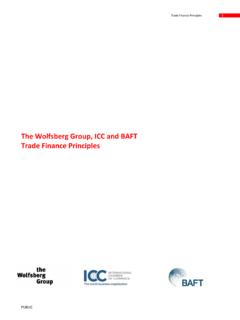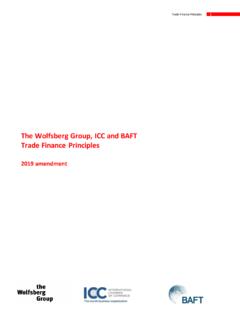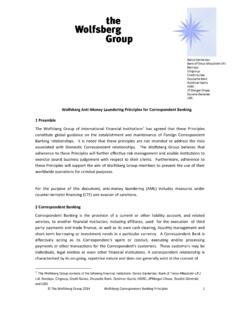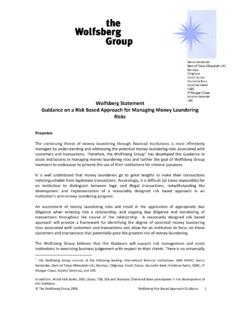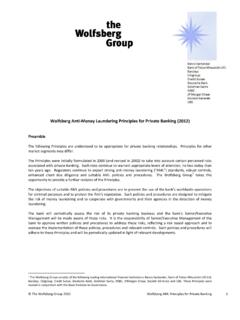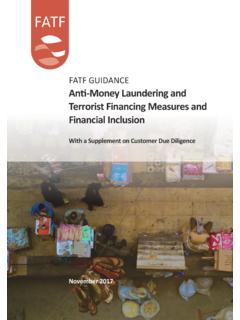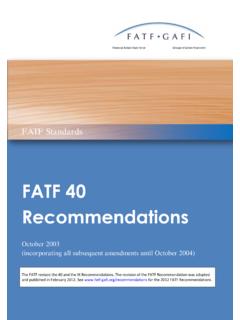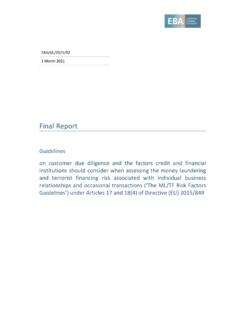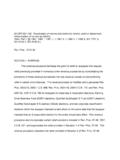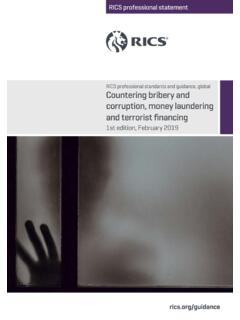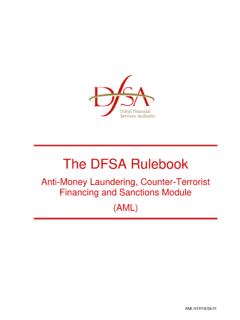Transcription of Wolfsberg Frequently Asked Questions (FAQs) on the ...
1 The Wolfsberg Group 2020 Wolfsberg FAQs on CBDDQ and FCCQ, 1 Wolfsberg Frequently Asked Questions ("FAQs") on the Correspondent Banking Due diligence and Financial Crime Compliance Questionnaires April 2020 The Wolfsberg Group 2020 Wolfsberg FAQs on CBDDQ and FCCQ, 2 Introduction The Correspondent Banking Due diligence Questionnaire ( CBDDQ ) was released to the banking community in October 2017. Alongside Publication Guidance, Completion Guidance and Glossary, the Frequently Asked Questions ( FAQs ) were created to provide additional context to the CBDDQ and Financial Crime Compliance Questionnaire ( FCCQ ) and add clarification based on feedback received from the industry since their publication. The FAQs is a live document and it will be updated as and when the need to include new topics is identified. The version control found on the cover and footnote of this document identifies the version number.
2 1. Why has the CBDDQ been updated? The original Questionnaire was a significant step forward when it was first published in 2004 and then updated in 2014; but as financial crime compliance programmes have evolved and become more sophisticated, the limitations of the original Questionnaire have become evident. This is evidenced by the creation of questionnaires by individual Financial Institutions (FIs) (including Wolfsberg Group members) with significantly more Questions than in the original. In response to both an increase in regulatory expectations, as well as a call for action from the Financial Action Task Force ( FATF ), the Financial Stability Board ( FSB ) Correspondent Banking Coordination Group ( CBCG ) and the Committee on Payments and Market infrastructure ( CPMI ), to strengthen and build efficiency in due diligence tools, the Wolfsberg Group ( the Group ) has revised its 2014 AML Questionnaire, focusing on cross-border and/or other higher risk Correspondent Banking relationships.
3 The CBDDQ constitutes a "reasonable and enhanced" question set likely to be satisfactory in most situations. 2. What is the difference between the previous Questionnaire and the CBDDQ? The CBDDQ is a considerably enhanced version, moving from 28 to 110 Questions , expanding content to cover Anti-Bribery and Corruption, Counter Terrorism Financing and Sanctions exposure controls and allowing for free text responses for certain Questions . The CBDDQ covers a respondent s control environment to allow FIs to obtain a greater level of understanding of the cross-border and/or other higher risk Correspondent Banking relationship they are entering into and/or continuing. 3. Why are there so many Questions in the CBDDQ? The CBDDQ has a broader scope, ( inclusion of Sanctions, Counter Terrorism Financing and Anti-Bribery and Corruption controls) and was created using the questionnaires of the Wolfsberg Group member banks as a starting point.
4 While the increase in the number of Questions appears dramatic, many FIs have already been answering a similar number of Questions (or more) that are Asked by different FIs to their respondents on a bilateral basis. The The Wolfsberg Group 2020 Wolfsberg FAQs on CBDDQ and FCCQ, 3 CBDDQ aims to introduce standardisation across the industry and reduce the inefficiency of multiple, different questionnaires. As a result, the Wolfsberg Group expects this CBDDQ question set, when completed, to act as a baseline to help satisfy FATF's Recommendation 13, that for "cross border correspondent banking" additional due diligence requirements must be undertaken, including for so called "high risk" correspondent banking relationships. 4. Has the CBDDQ replaced the previous questionnaire? Yes. The 2014 Questionnaire has been retired.
5 5. Is the CBDDQ sufficient for all cross-border and/or other higher risk Correspondent Banking relationships? Each FI should have its own risk appetite and risk tolerance and, while the Questionnaire will be sufficient in most circumstances, it is possible that the nature of the relationship, products used and geographies served may necessitate a broader conversation and additional Questions may have to be Asked . As a general approach, the CBDDQ should be used as the basis of bilateral CDD discussions between respondent and correspondent. 6. Should Central Banks complete the CBDDQ? If a Central Bank acts as a correspondent banking provider, either permanently or temporarily, then they should complete the questionnaire and identify themselves as Central Bank in the answer to question 13-J. 7. Should the CBDDQ be completed for SWIFT Relationship Management Application (RMA) non- customer relationships?
6 The Questionnaire was developed for cross-border and/or other higher risk Correspondent Banking relationships, which generate a higher risk compared to SWIFT RMA non-customer relationships. The Wolfsberg Guidance on SWIFT RMA Due diligence outlines the minimum due diligence standards required for non-customer RMAs. 8. What is the difference between the CBDDQ and the FCCQ? The CBDDQ and its guidance material provide a much more comprehensive set of Questions to address today s financial crime risks for cross-border and/or other higher risk Correspondent Banking relationships, aligning with FATF recommendation 13 and FATF Guidance on Correspondent Banking (October 2016). The latter states: FATF Recommendation 13 requires The Wolfsberg Group 2020 Wolfsberg FAQs on CBDDQ and FCCQ, 4 additional measures to be applied to cross-border correspondent banking relationships, in addition to performing the CDD and enhanced due diligence (EDD) measures in FATF Recommendation 10 for high risk customers.
7 Such additional measures are appropriate because cross-border correspondent banking relationships are seen to be inherently higher risk than domestic correspondent customer relationships. Consequently, simplified CDD measures are never appropriate in the cross-border correspondent banking context, when activities described in para. 13 (a) are conducted . The Entity is required to complete all Questions if engaged in cross-border and/or other higher risk Correspondent Banking services. The Group is also conscious that its original questionnaire has been used in multiple other customer type due diligence scenarios and therefore, while not seeking to prescribe how a revised questionnaire should be used for any other customer type, the Group has nonetheless updated the original version to align the phrasing with the CBDDQ for consistency purposes.
8 This revised version of the original questionnaire is called The Wolfsberg Group Financial Crime Compliance Questionnaire (FCCQ). Whatever process an FI chooses to follow in this regard, however, is at the sole discretion of the FI, although the Group would recommend that the FIs document their approach to due diligence appropriately. Unlike the CBDDQ, the FCCQ can be completed at the group level and encompass all the entities in the group. 9. Wolfsberg amended the CBDDQ and FCCQ on [insert date], when do we need to obtain updated Questionnaires from our respondents/customers? The Group will periodically and as needed update the CBDDQ and the FCCQ to reflect feedback or changes to regulatory requirements or the financial crime risk environment. The fact that the Group publishes an updated version of the Questionnaires does not invalidate already completed CBDDQs or FCCQs or serve as a trigger to update an FI s due diligence on its customers.
9 As mentioned in FAQ 17, Wolfsberg recommends the Questionnaires completed by Financial Institutions be updated on an annual basis. 10. Who should complete the CBDDQ? The CBDDQ should be completed by any FI which engages in cross-border and/or other higher risk Correspondent Banking services. The deeper level of information gathered reflects the complexity and higher expectations of Banks with global networks, as well as the heightened scrutiny on those activities by other Banks and Regulators. 11. Who should complete the FCCQ? The FCCQ is not intended for use for cross border or higher risk correspondent banking activity which must be addressed through the CBDDQ. The Wolfsberg Group 2020 Wolfsberg FAQs on CBDDQ and FCCQ, 5 The FCCQ may be used for Banks or other FIs to obtain high-level information about the Financial Crime Compliance Programme of the entity completing the document.
10 The questionnaire responses will help in assessing whether a customer has all required elements expected of a Financial Crime Compliance Programme. Each institution should determine the appropriate use of the FCCQ in conjunction with their internal policies and jurisdictional requirements. An FI may find that, having completed the CBDDQ, the FCCQ can then also be completed relatively easily. Some FIs have chosen to make the FCCQ available publicly via their websites, while providing the CBDDQ on a more limited basis where the nature of the relationship warrants. 12. How should FIs complete the CBDDQ or FCCQ? FIs should complete the questionnaires accurately and with up to date information. FIs completing the questionnaires should consider how the information can be validated and quality assured, to ensure reliability of the information provided.

